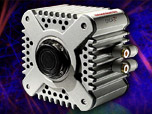Image Galleries
Featured Article
 Electron Multiplying Charge-Coupled Devices (EMCCDs)
Electron Multiplying Charge-Coupled Devices (EMCCDs)
By incorporating on-chip multiplication gain, the electron multiplying CCD achieves, in an all solid-state sensor, the single-photon detection sensitivity typical of intensified or electron-bombarded CCDs at much lower cost and without compromising the quantum efficiency and resolution characteristics of the conventional CCD structure.
Product Information
Interactive Java Tutorials
Resolution (Airy Disk/Intensity Profile)
The ultimate resolution of a charge-coupled device image sensor is a function of the number of photodiodes and their size relative to the image projected onto the surface of the imaging array by the microscope optical system. When attempting to match microscope optical resolution to a specific digital camera and video coupler combination, use this tutorial for determining the minimum pixel density necessary to adequately capture all of the optical data from the microscope.
The efficiency of capturing images generated by an optical microscope onto the photodiode array of a CCD image sensor is dependent upon several factors, ranging from the objective magnification, numerical aperture, and resolution, to the electronic image sensor photodiode array size, aspect ratio, video coupler magnification, and the dimensions of individual photo-sensitive elements within the array. In addition, parameters that are specific to the specimen being imaged, such as contrast, signal-to-noise ratio, intrascene dynamic range, and integration time, must also be considered.
The ultimate optical resolution of a CCD is a function of the number of photodiodes and their size relative to the image projected onto the array surface by the microscope lens system. Currently available CCD arrays vary in size from several hundred to many thousands of pixels. Modern array sizes used in devices intended for scientific investigations range from 1000 x 1000 up to 5000 x 5000 sensor elements. The trend in consumer and scientific-grade CCD manufacture is for the sensor size to continuously decrease, and digital cameras with photodiodes as small as 4 x 4 micrometers are currently available.
Adequate resolution of a specimen imaged with the optical elements of a microscope can only be achieved if at least two samples are made for each resolvable unit, although many investigators prefer three samples per resolvable unit to ensure sufficient sampling. In diffraction limited optical instruments, such as the microscope, the Abbe limit of optical resolution at an average visible light wavelength (550 nanometers) is 0.20 micrometers when using an objective lens having a numerical aperture of 1.4. In this case, a sensor size of 10 square micrometers would be just large enough to allow the optical and electronic resolution to be matched, with a 7 x 7 micrometer sensor size preferred. Although smaller photodiodes in a CCD image sensor improve the spatial resolution, they also limit the dynamic range of the device.






